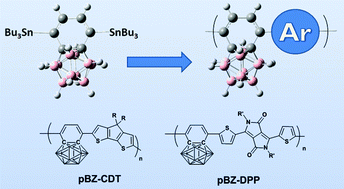In addition to making the study of chemistry more complicated than it needs to be, three-centre-two-electron bonds also provide carboranes with many useful properties. The inclusion of carborane clusters allows the thermal and chemical stability of polymers to be improved, glass transition temperatures to be increased and the propensity for unwanted aggregation to be reduced.
Recent work by Marshall et al. has focused on the incorporation of ortho-carborane into conjugated polymers for use in organic electronics. Carboranes are of particular interest in this area due to the possibility that their electron deficiency will allow them to fulfil the role of the electron acceptor in a donor-acceptor polymer. By preparing a novel monomer based on benzocarborane, it was possible to carry out a Stille polymerisation with an electron donating monomer and prepare polymers with molecular weights of the order of 10 kDa.
In comparison to analogous materials that contained no carborane, both novel polymers showed a decrease in band gap. One polymer was found to behave as a p-type semiconductor in a field effect transistor (FET) – the first time that a carborane-containing polymer has been used in such a device.
Incorporation of benzocarborane into conjugated polymer systems: synthesis, characterisation and optoelectronic properties
Jonathan Marshall, Zhuping Fei, Chin Pang Yau, Nir Yaacobi-Gross, Stephan Rossbauer, Thomas D. Anthopoulos, Scott E. Watkins, Peter Beavis and Martin Heeney
J. Mater. Chem. C, 2014, 2, 232. DOI:10.1039/C3TC31663g
James Serginson is a guest web writer for the Journal of Materials Chemistry blog. He currently works at Imperial College London carrying out research into nanocomposites.
To keep up-to-date with all the latest research, sign-up to our RSS feed or Table of contents alert.











